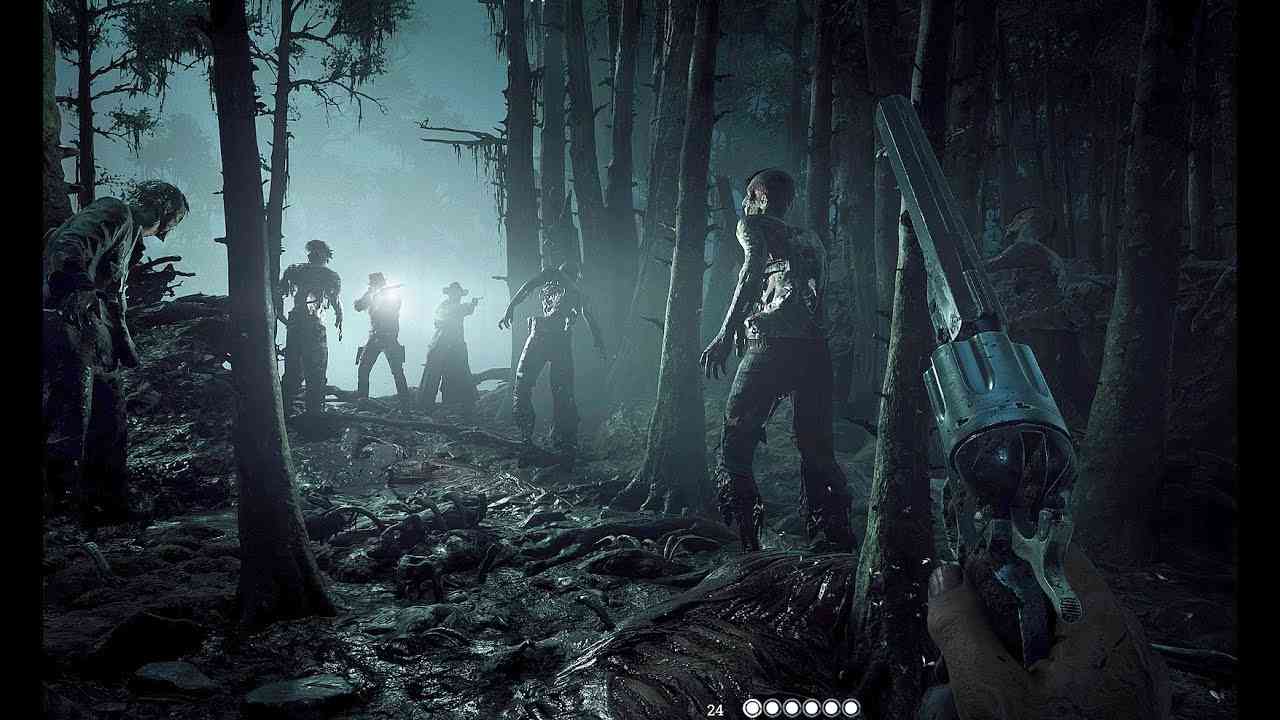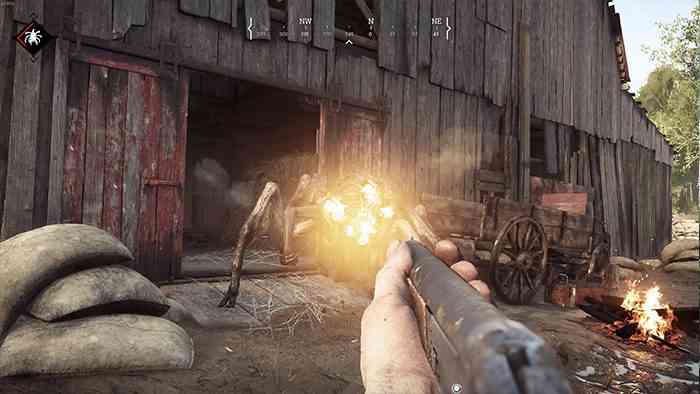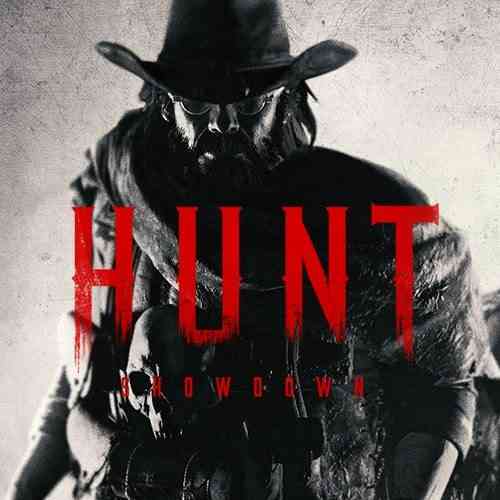Hunt: Showdown PC Review
I won’t remotely sugarcoat it. Hunt: Showdown is one of my favorite games of all time. I’ve been singing its praises since day one of early access, and while my four hundred logged hours pale in comparison to those of other veterans, I believe they warrant valid criticism. I’ve honestly never been this excited to review a game, so I’ll get right into it.
Hunt: Showdown is a PvPvE bounty hunting game based in the bayou of late 19th century Louisiana. In the main bounty hunt mode, your goal is to kill, banish, and escape with the bounty of one or two bosses. Spread across the maps are clues that reveal the compounds in which bosses are located. Along the way, you’ll encounter a myriad of horrific AI creatures like grunts, armored, hive, meatheads, and Hellhounds. All present you with unique challenges, but rival players pose the greatest threat. You and up to nine additional players compete for the same bounties. The players who escape with bounties receive the highest reward, while the rest either die or escape the map with a lesser profit.
Let’s Put Some Heads To Bed
Entering a match of Hunt is akin to a battle royale with significantly higher stakes. To play a match, you must recruit and outfit a hunter with weapons, tools, consumables, and traits; all of which come at an in-game cost. Every penny you invest could be lost within minutes of entering a match. Once a hunter’s killed, they and their loadout are gone for good. Therefore, your decisions in the lobby and in the world carry tremendous weight. Frankly, it’s a drug I’ve grown addicted to over four hundred hours. I’ve certainly gained a level of confidence since the early days, but today I still experience the tension of PvP firefights, overwhelming PvE encounters, and wild escapes with a bounty.
Progression is tied to your Bloodline. Bloodlines track your overall rank and statistics including K/D, boss kills, monster kills, and more. Between level 1 and 100, you unlock a ton of various weapons, tools, consumables, traits, and Hunter Tiers. Tier 1 hunters have access to the bare-minimum while Tier 3’s have improved health chunk options, concealing outfits, and a broader selection of gear. What’s beautiful is that while high-level weapons pack a deadlier punch, victory ultimately lies in strategy. While there are scenarios with exceptions, tactics and wit almost always overcome any loadout. Every match packs high risk/reward competition across a level playing field that’s been refined over a year and a half in early access. Once you’ve reached max level, you can prestige up to fifty times to receive new count badges and legendary weapon skins.

There’s also an awesome layer of depth to leveling individual hunters. Hunters possess a sub-level between 1 and 50. The higher level the hunter, the more experience you receive upon winning matches. Once a hunter reaches level 50, you have the option to retire them for bonus experience toward your Bloodline; plus maxed out hunters are logged in your Bloodline for all to revere. That depth extends to loadouts. All playstyles are accommodated through long, medium, and short-range, stealth, and melee. You can recruit up to five hunters at once and outfit them all differently, contributing to the diversity of every match. Though I often cater to stealth, I’ve used every weapon, tool, consumable, and trait for many hours and can attest to the balanced pros and cons of each. Relative balance took a while to achieve, but Crytek has reached an excellent place with 1.0.
While you can play solo or up to a party of three in bounty hunt, Quickplay’s an entirely different experience. You choose a preset loadout and head into the map alone to close rifts, absorb the wellspring’s energy, and escape the map with your soul. While you’re at it, you can scavenge other weapons and gear to alter your strategy. I prefer bounty hunt, but Quickplay’s great for a faster, more streamlined experience when you’re short on time or need a break from the tension of the primary experience.
Hunt’s maps, Stillwater Bayou and Lawson Delta, are both exceptionally designed. Stillwater’s the original and easily my favorite between the two. It often leads to closer encounters with opposing hunters while Delta tends to end in long-range shootouts. Both are rife with points to take advantage of regardless of strategy, but the best aspect is that there are endless possibilities. Whether your battle occurs in the depths of a forsaken cathedral or atop a towering prison, every encounter with AI and other players is unpredictable. You begin to feel like a tried and true hunter once you’ve memorized the layout of each. Doing so enables you to enact effective strategy, especially when your vision’s inhibited at night or in a dense fog. Both present beautifully horrific atmospheres and provide a strong sense of dread. There’s a lot of compelling lore from Hunt’s world to explore online, but the maps alone spell harrowing tales.

Hunt currently features three bosses: Butcher, Spider, and The Assassin. In knowing their weaknesses, the battles aren’t inherently difficult, but how you bring them down determines the outcome of the match. If you manage to silently kill one, your chances of banishing them and escaping unscathed are likely. Slaying them through an onslaught of gunfire and explosives alerts opposing players to your position significantly faster. Each boss provides a unique combat experience, and all are enhanced when enemy hunters attempt to intervene. There are also few feelings as thrilling as your compound being surrounded while you have the bounty in hand. In carrying one, you have five seconds of Darksight boost, which enables you to spot player energy through barriers. Darksight boost initially didn’t exist at all, and originally provided you with ten seconds as opposed to five. While there is a part of me that misses its absence, five seconds is far more appropriate than ten, as the ability formally felt a bit too convenient for the hardcore nature of the game.
Time Well Spent
I’ve spent all of my four hundred hours on PC. Between shooting, slashing, running, sneaking, and vaulting, Hunt’s mechanically on point. Crytek enables you to intricately tweak your preferences between weapon sensitivity, key binds, and the HUD. Sitting down to play Hunt felt incredibly awkward at first, but I quickly grew fond of the odd, default control scheme and believe it actually contributes to a more realistic sense of handling firearms on mouse and keyboard. In 1.0, I haven’t found myself getting snagged on objects or trapped in bizarre spaces within the game world. Hunt doesn’t feature AAA levels of polish, but it feels impressive to play.
CryEngine’s remarkably powerful and is on full display with Hunt: Showdown. While I’m only capable of maintaining a satisfying frame rate at 1440p and medium settings, I have witnessed the game running at 4K on max. It’s absolutely gorgeous. The grisly art design is beautifully rendered, but its magnum opus is the lighting. In general, the game’s stunning, but it’s most breathtaking at night due to the glow of moonlight cutting through trees and dilapidated structures and the warm glow of fire illuminating points on the maps. Playing at night is also far more eery, nerve-racking, and challenging, and I believe it’s the best way to experience the game. Hunt’s animations aren’t groundbreaking, but they look nice within the world. Audio is equally superb in the unsettling ambient atmosphere, weapon and monster sounds, and the ability to use sound to your advantage. Keeping an ear out for nearby hunters is paramount to survival, and employing audible distractions can make or break encounters. Overall, the game demands the best of your rig. Optimization has drastically improved, but instances of performance dips still occur from time to time.

Connection issues and the lack of persistent parties are my only grievances in 1.0. My internet’s regularly stable across many multiplayer games, but I’m still experiencing an occasional lag in Hunt. It isn’t at all game-breaking, and fortunately, the instances are rare. Persistent parties have been absent since the beginning. Having to re-invite a friend to your lobby every time you win or lose continues to be inconvenient. However, persistent parties are coming to update 1.1 in the near future.
Additional features include daily and weekly challenges that grant small rewards, and a library of lore detailing the game’s weapons, monsters, and bosses. Hunt’s killer soundtrack by Port Sulphar Band is available on streaming platforms, and the cosmetics-focused Legends of the Bayou DLC is available now. New to 1.0 is Hunt’s secondary currency called Blood Bonds. They can be earned in-game or purchased with real money to unlock access to legendary weapon and hunter skins, and an additional hunter slot. I have limited interest in these amenities, as my adoration for the game is rooted in gameplay. However, they exist for those who want them and don’t inhibit the experience.
Little did I know that in being tasked with capturing gameplay for week one of early access that Hunt: Showdown would go on to become one of my all-time favorite video games. I’ve actually had to refrain from expressing many of the countless aspects I love. Fortunately, for Hunt’s sake, the majority of its glaring issues were resolved prior to the launch of 1.0. Aside from rare connection issues, Hunt: Showdown is unequivocally one of the best PvPvE experiences of this generation. It’s certainly not for everyone, but if you’re a junkie for hardcore, competitive, survival-based multiplayer in a horrific setting, I strongly recommend paying a visit to the bayou.
For more on Hunt: Showdown, you can check out my five tips for winning here. It’s a bit dated, but many of my suggestions still stand.
***PC code was provided by the publisher***
The Good
- Diverse, addictive, high-stakes gameplay
- Exceptional design
- Gorgeous presentation
The Bad
- Occassional connection issues
- Occassional dips in performance
- Lacking some quality of life features

